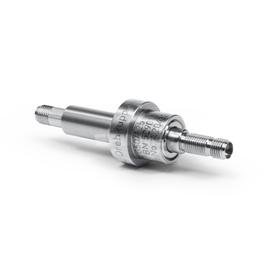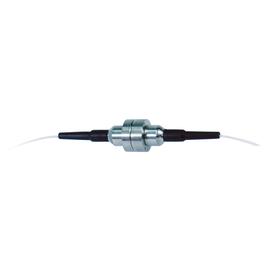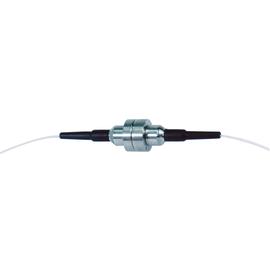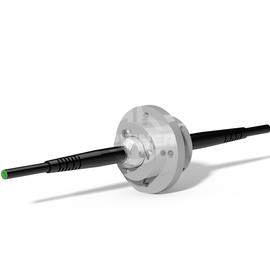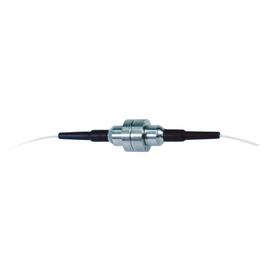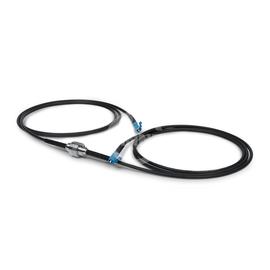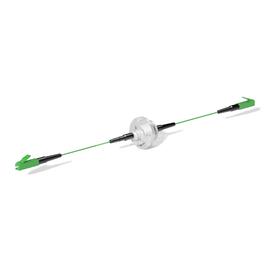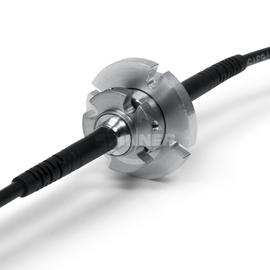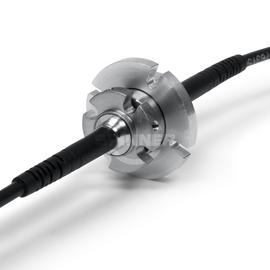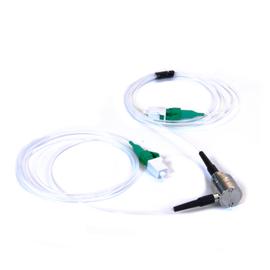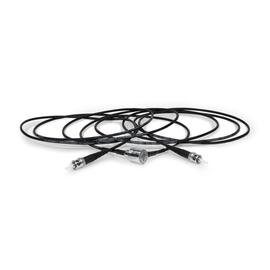Stationary cranes – rotary joints are a crucial component for transmission of power and signals
Stationary or site-bound cranes are used across various industries for lifting and moving heavy loads in a fixed location.
- Construction Industry: Lifting and moving construction materials and equipment in building construction, infrastructure development, bridge construction, and high-rise construction.
- Manufacturing Industry: Handling heavy machinery, equipment, and raw materials within manufacturing facilities, e.g. automotive manufacturing, steel production, aerospace manufacturing, and general industrial processes.
- Ports and Shipping Industry: Loading and unloading cargo from ships and containers at ports, harbors, shipping terminals, and container yards.
- Power Generation Industry: Handling heavy components, equipment, and materials in power plants e.g. thermal power plants, nuclear power plants, hydroelectric power plants, and renewable energy facilities.
- Mining and Extraction Industry: Lifting and transporting heavy materials, ores, and minerals at open-pit mines, underground mines, quarries, and mineral extraction sites.
- Oil and Gas Industry: Handling equipment, pipes, and containers in oil and gas exploration, production, and refining at offshore platforms, onshore drilling sites, refineries, and petrochemical plants.
- Warehousing and Logistics Industry: Efficiently moving and stacking goods within large warehouses and distribution centers at distribution hubs, logistics centers, e-commerce warehouses, and large-scale storage facilities.
- Heavy Infrastructure Industry: Handling large-scale infrastructure components and materials for bridge construction, dam projects, railway infrastructure, and road construction.
- Waste Management Industry: Handling and moving waste materials, recyclables, and debris at landfills, recycling facilities, waste transfer stations, and waste management operations.
- Shipbuilding and Repair Industry: Moving and assembling ship components during construction and repair activities at shipyards, shipbuilding facilities, and dry docks.
These industries utilize stationary cranes to enhance productivity, improve safety, and efficiently handle heavy loads within their respective operations.
Fixed cranes typically transmit several types of data and information to support their safe and efficient operation. Here are some examples:
- Load weight: local cranes use load cells and sensors to measure the weight of the load being lifted, which is transmitted to the crane operator through a display or gauge. This information is critical for ensuring that the crane is not overloaded, which could cause it to tip over or fail.
- Crane status and diagnostics: Modern stationary cranes may have sensors and onboard computers that monitor various aspects of the crane's performance, including engine temperature, hydraulic pressure, and other parameters. This data can be transmitted to the crane operator or to maintenance personnel for analysis and troubleshooting.
- Video feeds: Some cranes may be equipped with cameras or other sensors that provide a live video feed of the lift area, which can be transmitted to the crane operator or to a central control system. This information can be useful for ensuring that the load is properly positioned and for identifying potential hazards.
Overall, the data and information transmitted by cranes is designed to support safe and efficient operation, while also providing real-time feedback on the crane's performance and status.
In order to transmit signals through rotating elements of a site-bound crane, such as the boom or jib, special slip rings are often used. Slip rings are devices that allow electrical signals and power to be transferred between stationary and rotating components. They consist of two main parts: a stationary brush assembly and a rotating ring assembly.
There are several alternatives to slip rings that can be used to transmit signals and power through rotating elements of a crane. One alternative is contactless rotary joints, which use wireless or optical technology to transfer data and power across the rotating joint.
Here are some examples of contactless rotary joints:
- Wireless power transfer (WPT): WPT technology uses magnetic fields to transfer power wirelessly across a small gap between a stationary coil and a rotating coil. This technology can be used to power small electronic devices in the rotating part of the crane.
- Fiber optic rotary joints (FORJ): FORJ technology uses optical fibers to transmit data across a rotating joint. The optical fibers are connected to a stationary connector that transmits the data to the crane's control system.
- Inductive rotary joints: Inductive rotary joints use electromagnetic induction to transfer power and data across a rotating joint. These joints can be used to power motors and other electrical devices in the rotating part of the crane.
- Capacitive rotary joints: Capacitive rotary joints use capacitive coupling to transfer power and data across a rotating joint. These joints can be used to power sensors and other low-power devices in the rotating part of the crane.
Each of these technologies has its own advantages and disadvantages, and the choice of technology depends on the specific application and requirements of the crane. For example, wireless power transfer may be suitable for powering small devices but may not be able to provide enough power for larger motors. Similarly, fiber optic rotary joints may provide high-speed data transfer, but may be more expensive than other options.
Key success factors for implementing a rotary joint in a stationary crane
Implementing a rotary joint in a stationary crane requires careful consideration of several factors to ensure that the joint functions reliably and safely. Here are some key success factors to consider when implementing a rotary joint in a stationary crane:
- Structural integrity: The rotary joint must be designed to withstand the higher loads and forces experienced by stationary cranes, ensuring its structural integrity and stability.
- Integration with support structures: The joint should be seamlessly integrated into the overall design of the crane's foundation and support structures, ensuring proper alignment and support.
- Power compatibility: The rotary joint should accommodate the higher power requirements typically found in site-bound cranes, facilitating the smooth transmission of power to larger motors and equipment.
- Environmental resilience: The joint must be designed to withstand long-term exposure to environmental factors such as corrosion, extreme temperatures, and moisture, ensuring reliable operation under these conditions.
- Convenient maintenance: The joint should allow for easy access to inspection and replacement of components, taking into account the accessibility of maintenance points in stationary cranes.
- Safety assurance: The joint should meet safety standards, ensuring it does not introduce additional risks to crane operators or maintenance personnel.
- Reliability and longevity: The joint should be designed with high-quality components to ensure long-term reliability and minimize downtime or failure.
- Compatibility with control systems: The joint should be compatible with the communication protocols used in the crane's control system, facilitating seamless integration and data transmission.
- Safety: The rotary joint must be designed to ensure safe operation of the crane. This includes ensuring that the joint does not introduce any additional risk of electrical shock or other hazards to crane operators or maintenance personnel. The joint must also be designed to prevent any signal or power loss that could cause the crane to malfunction or fail.
- Cost: The cost of implementing a rotary joint in a crane can be significant, so it is important to consider the cost-benefit analysis of the joint. The benefits of the joint must outweigh the costs, and the joint must provide a competitive advantage to the crane in terms of performance and reliability.
By considering these factors and carefully designing and testing the rotary joint, a crane can benefit from improved performance, reliability, and safety.
The rotary joint allows for continuous transfer of electrical power and signals
Rotary joints are a crucial component for transmission of power and signals in cranes. The primary function of a rotary joint in a cable reel, rotating elements of the jib or boom is to enable the transfer of electrical power, control signals, and other types of data and information from the fixed power source and control system to the rotating cable reel drum or the crane machinery.
The rotary joint consists of a stationary part (stator) and a rotating part (rotor). As the cable reel drum, jib or boom rotates, the rotary joint allows for continuous transfer of electrical power and signals from the fixed power source and control system to the crane machinery without any interruption. This continuous transfer of power and signals ensures that the crane can operate efficiently and safely.
There are several key requirements that must be considered when designing and selecting rotary joints for cable reels used in mobile cranes. These requirements include:
- High performance: SPINNER rotary joints offer low insertion loss or excellent VSWR (Voltage Standing Wave Ratio) performance, ensuring reliable transfer of electrical power, radiofrequency or optical signals with minimal power loss or signal distortion.
- Durability and reliability: SPINNER rotary joints are designed and manufactured to withstand harsh environmental conditions, which includes exposure to dust, moisture, saltwater corrosion in marine environments or high temperatures, and frequent use, ensuring reliable and long-lasting performance. They are designed to withstand the constant rotation of the cable reel drum and the stresses associated with crane operation.
- Minimal maintenance requirements: SPINNER rotary joints require minimal maintenance and are designed for easy repair and replacement, reducing downtime and maintenance costs.
- Wide range of options: SPINNER offers a wide range of rotary joint options, including different sizes, frequencies, technologies and (rf, fiber optics, Ethernet, …) and power handling capabilities, allowing for greater customization and flexibility in design.
- Integration with automation systems: SPINNER rotary joints can be integrated with automation systems for remote monitoring and control, allowing for more efficient and streamlined operations.
SPINNER rotary joints offer several advantages, including a wider range of options, higher electrical performance, and better durability and reliability. Additionally, SPINNER's focus on customization and flexibility allows for more tailored solutions to meet the specific needs of cranes.
